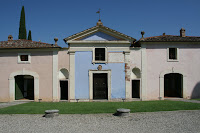For two weeks in January, the Niagara region plays host to the highly anticipated Icewine Festival every year. Last year, I made the rounds to various vineyards using the festival’s “Discovery Pass” and braved an extreme freeze to sample numerous wines paired with sweet and savoury nibbles. This year, I switched the thermal wear for formal wear and attended the Xerox Icewine Gala at the Fallsview Casino and Resort in Niagara Falls.
Sparkling chandeliers and ice sculptures adorned the ballroom where wines from over twenty-five of Ontario’s wineries were on offer. Hernder Estates, Château des Charmes, Tawse Winery, Reif Estate Winery and Fielding Estate Winery were amongst the numerous purveyors offering sips of everything from sparkling to premium wines.

Reif Icewine Flight with local cheeses
I choose some bubbly from Château des Charmes and a plate of the evening’s standout dish- a rich risotto made with red wine and gorgonzola, topped with candied pecans. I grab a perch at a cocktail table and meet Joe and Beth, two Bostonians who for the past nine years, drive nine hours to get to the Icewine Festival! I had to know- why are they such festival stalwarts? Joe responds, “Because we love icewine! You don’t get anything like this where we’re from so we make sure to get our fill while we’re here.”

Candied apple desserts at the Gala
Fluke? Possibly until I meet Dr. Michael from Miami, Florida who, like my new pals from Boston, is an Icewine festival devotee. “The doctors at the hospital know not to mess with my Icewine Festival week. This week in January is MINE!” says Dr. Michael with a smile. Indeed- who would want to keep a man from his vino?
The next day, we visit Ravine, Reif, and Stratus vineyards. The food pairings at Ravine were outstanding! The owners’ son Paul, just back from a stage in Germany, made the best pork rillettes I’ve ever had, hands down. Wine consultant Peter Gamble explained the unique terroir of St. David’s bench and we sampled the fruits of the family’s labour of love. German-born Klaus Reif regaled us with four varieties of icewine- from a 2008 Riesling to a 2008 Cabernet Franc. But it’s the 2007 Vidal Icewine that most impresses my palate with lush tropical fruit off the top and a balanced acidity at the end that’s perfectly crisp.

We end the day at the Twenty Valley Winter Winefest where open fires, more wine and food are on offer from this particular corner of the region. Sated and tired, I meander back to the car with words like “brix” (sugar present in wine) swirling in my mind. I know this is the science part of icewine making, but the smooth flavour of the Stratus Riesling icewine lingers, so I know it’s alchemy at work here. Maybe even some magic…
Photos by Mary Luz Mejia





.JPG)

 We walked to the waterside promenade- The Riva- where locals suggested we try just caught fish and a local specialty- blitva. Boiled potatoes, wilted swiss chard, caramelized garlic gently bathed in a light olive oil makes the most perfect partner to a piece of freshly grilled brancin (or sea perch) with a glass of fabulous local Malvasia wine. It was all I could do to muster a sincere “Puno hvala” (thank you very much) to our suntanned server who smiled at my kid-like attempt to speak his language. In mid-stride, he stopped, turned around and in stilted English replied “You are very welcome! Come back and visit us again.” You can count on it!
We walked to the waterside promenade- The Riva- where locals suggested we try just caught fish and a local specialty- blitva. Boiled potatoes, wilted swiss chard, caramelized garlic gently bathed in a light olive oil makes the most perfect partner to a piece of freshly grilled brancin (or sea perch) with a glass of fabulous local Malvasia wine. It was all I could do to muster a sincere “Puno hvala” (thank you very much) to our suntanned server who smiled at my kid-like attempt to speak his language. In mid-stride, he stopped, turned around and in stilted English replied “You are very welcome! Come back and visit us again.” You can count on it!












